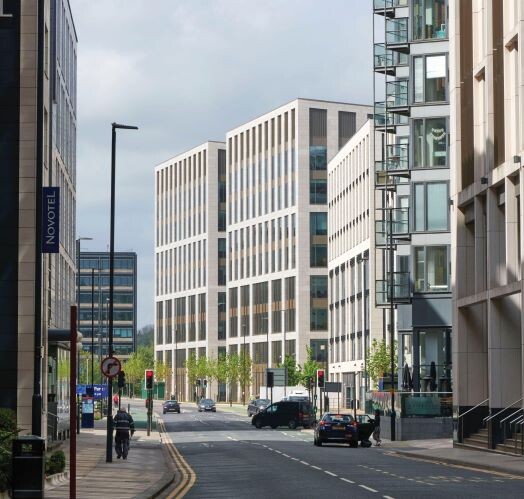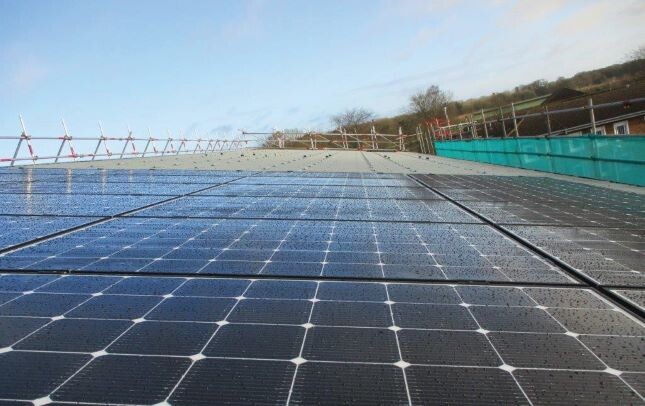Cop26, the widely promoted as a landmark climate change conference, is now upon us. The meeting, which began in Glasgow yesterday, is expected to galvanise efforts to cut greenhouse gas emissions. The focus will be on national and global emissions but the UK government is also required to do its bit internally. After all, the civil service, with more than 400,000 staff across the UK and producing almost 2m tonnes of carbon dioxide (CO2) a year, is the equivalent of a small city. NHS emissions alone are equivalent to 4% of England’s total carbon footprint. Clearly, hosting Cop26 makes it even more imperative that the government demonstrates that it is keeping its own estate in order.
Individual government departments have been monitored since 2014 under an initiative known as Greening Government Commitments. Energy and carbon reduction targets apply to 22 central government departments and non-ministerial government departments and their arm’s-length bodies: they cover the entire civil estate, comprising offices, warehouses, job centres, test centres, courts and operational uses such as prisons. Everything from the departmental number of flights and water consumption to plastic cutlery, paperless operations and retrofitting beautiful Grade I listed but energy-hungry buildings has come under the spotlight.
This is, to put mildly, something of a challenge: it’s estimated that the built environment contributes around 40% of annual global greenhouse gas emissions and that around 80% of existing buildings will remain in use by 2050: the ratio for UK government department buildings is similar.
Operational targets are reported quarterly; procurement and transparency commitments on an annual basis. Permanent secretaries and chief executives are accountable for their delivery and for compliance with performance management and reporting requirements. The aim of net zero carbon emissions by 2050 has been incorporated into obligations too. Just to keep everyone on their toes, departmental performance league tables are published annually. Or at least they were.
The last publication came in 2019, with the 2018-2019 report. It’s understandable that the 2019-2020 report was delayed as the pandemic unfolded, yet 20 months after the first lockdown, the government has failed to publish not only the 2019-2020 report but the 2020-2021 report.
Despite repeated enquiries by CSW since May, the Department for Environment, Food and Rural Affairs has failed to either provide a date when they might be published nor offer any explanation for their delay. Jill Rutter of the Institute for Government has some sympathy for departments tasked with providing data as Covid swept through the country. “On the one hand part of this is just about reading off monitoring targets but doing the reports and putting things in context is quite labour intensive so you could say it’s fair enough that it was not the absolute priority over the past year,” she says.
Yet it still seems surprising. Not only is the UK hosting Cop26 but the government has published its detailed plan for how the UK will reach net zero emissions by 2050. In addition, NGOs such as the World Wildlife Fund for Nature have called on the Treasury to take on powers to make green spending decisions, which encourage in-house and UK-wide spending policies to be determined by what is best for the environment and for achieving net zero rather than on crude price.
Despite the absence of multi-departmental GGCs and of any explanation for their delay, the Cabinet Office has published a State of the Estate report for 2019-2020 and Defra has also published its own GGCs for 2020-2021.
The Defra report shows that for the four quarters (up to April 2021), compared to 2009-10, paper use had been reduced by 97% against a target of 50%; domestic flights (for obvious reasons) had been reduced by 98% against a target of 30%; greenhouse gas emissions had dropped by 59% against a target of 44%; 16% of waste went to landfill against a target of less than 10%; and water use reduced by 10% against a target of 23%.
“Fourteen departments have made reductions in emissions of 50% or more compared to the 2009-10 baseline”
Yet progress appears uneven when compared to the last dataset produced before lockdown (Q1 from 2020). The latest pre-covid figure for CO2 emissions from buildings was 10,310 tonnes but this rose to 14,657 tonnes in Q4 2021. Waste has also risen from 863 tonnes to 997 tonnes, and the landfill ratio has increased from 13% to 19%. More positively, water use from all buildings has dropped from 148,767 m3 to 96,668 m3.
Defra also says it has installed an unspecified number of self-generating installations onto its sites, such as wind turbines, photovoltaic panels, solar water heaters and ground source heat pumps. A statement added that the department is also committed to rolling out the use of biomass boilers, though again it has been unable to provide numbers. The Defra group has also achieved the government’s consumer single use plastic commitment to remove single use plastic.
Campaign groups such as WRAP, however, point out that the European single use plastic directive was not transposed into UK law before the end of the Brexit transitional period so the UK is not required to implement its requirements. While Defra has bans in place for stirrers and cotton buds, these do not automatically cover cutlery, plates and polystyrene food containers.
Meanwhile, the State of the Estate 2019-2020 report summarises the latest progress on improving the efficiency and sustainability of the government estate in accordance with the 2008 Climate Change Act. The estate was required to reduce greenhouse gas emissions by at least 43% from a 2009-10 baseline by 2020. Overall, this has been exceeded – the actual reduction over this timeframe is 50%. The report estimates that 31% of the reduction in emissions was due to the improved management of the estate and a further 19% was due to the decarbonisation of the National Grid. Fourteen departments have made reductions in emissions of 50% or more compared to the 2009-10 baseline (though the report does not say which have failed to do so, or by how much). The NHS has achieved an estimated a 62% reduction in emissions since 1990, which significantly exceeds the 37% requirement for 2020 outlined in the Climate Change Act.
Specifically, in 1990 the NHS was estimated to produce 16.2m tonnes of CO2 equivalent; by 2019 this has been reduced to 6.1m tonnes, with a similar figure estimated for 2020. In January 2020, the campaign for a greener NHS was launched to mobilise 1.3 million staff and set an evidence-based route map and date for the NHS to reach net zero.
“Does it really matter if a small department achieves net zero? No, not at a global level but it’s about the message” Jill Rutter
The State of the Estate report found that reductions in energy consumption saved the government an estimated £148m in 2019-20. The proportion of waste which is recycled was 64%, a slight decrease compared to last year’s 65%, though it still saved the government an estimated £24.9m in costs.
Government as a whole reduced its paper consumption by 63% in 2019-20 compared to the baseline – exceeding the 50% 2020 target and improving on last year’s 59% reduction; 15 departments exceeded the 50% target. Of these, eight recorded reductions of over 70% (again, the stragglers have not been identified). All but four departments reported a reduction in water consumption compared to the baseline. An estimated £9.5m savings were achieved through reduced water consumption.
Along with greenhouse gas emissions (GHGs), the other key metric by which departments must cut energy is the Energy Performance Certificate (EPC) which sets out the potential energy efficiency rating of a property. Since 2008, properties that are sold or let generally require an EPC, which is valid for 10 years. When it comes to energy efficiency of buildings (many of them listed), the challenges become apparent. The report found that just four buildings achieved an Energy Performance Certificate rating of A+, 12 achieved A and 85 a B; 299 were rated C; 401 were rated D; 15 were rated the lowest category G.

New-build properties which are constructed to more demanding energy efficiency standards will, over time, improve this picture. The report points to 7 & 8 Wellington Place, which is the foundation for the Government Hub for Leeds and will house over 6,000 civil servants from HM Revenue & Customs, NHS Digital and the Cabinet Office. The building has been designed to meet the “Excellent” BREEAM rating, using BIM Level 2 (Building Information Modelling) and co-ordination before on-site assembly, reducing errors and raising quality. The piling and under-slab formation is 100% recycled aggregates and 98% of the construction waste has been diverted away from landfill.
 In addition, the Ministry of Justice has reviewed its part in meeting the government’s net-zero commitment (it holds the second largest estate after the Ministry of Defence, with 177 prisons and accounts for more than 20% of central government’s total GHG emissions). Two new prisons under construction conform to BREEAM Excellent ratings and will provide electric vehicle charging points for 20% of staff and visitors. The MoJ aims to be fully net zero in operation for prisons built in the next five years.
In addition, the Ministry of Justice has reviewed its part in meeting the government’s net-zero commitment (it holds the second largest estate after the Ministry of Defence, with 177 prisons and accounts for more than 20% of central government’s total GHG emissions). Two new prisons under construction conform to BREEAM Excellent ratings and will provide electric vehicle charging points for 20% of staff and visitors. The MoJ aims to be fully net zero in operation for prisons built in the next five years.
Rutter reiterates the importance of departmental in-house greening. “Does it really matter if a small department achieves net zero? No, not at a global level but it’s about the message.
“A lot of businesses that say they are addressing net zero are not really doing net zero, and those that are say it is really hard – so the government needs to be seen to be doing this to persuade other players in the economy to do it. If the government tells everyone to do one thing but does another it’s terrible for moral, compliance and leadership,” she says.
The concept of net zero has also changed departmental attitudes, suggests Rutter. “When the target was an 80% reduction in emissions, some departments would assume they’d be in the other 20% and every department thought they’d have some sort of exemption. That would soon have seen the 20% expand to 80%,” she says. “Departments could have argued they had to wait for the energy sector to come up with solutions and then implement them – but net zero makes departments look to implement energy efficiency measures now. With net zero, everyone has to come up with solutions rather than problems. There’s no hiding place.”
Rutter points to examples within the prison service, where recyclable mattresses feature in procurement processes; and in housing, where officials might previously have said their priority was affordable housing – but now have to incorporate net zero into achieving their goals. “Net zero is hard and if government feels things biting in-house as it tries to achieve net zero then will have a better appreciation of what other sectors of the economy will experience.’”
A statement issued by Defra said: “The new Greening Government Commitments framework for 2021-25 will further ensure we reduce our environmental footprint, align with commitments in the 25 Year Environment Plan and help us towards achieving net zero greenhouse gas emissions by 2050.
“It is vital that new facilities are built to modern, net zero standards, take account of whole life costs, and apply best practice construction standards to deliver longer term value for money and carbon reduction. We aim to transform the government estate into a sustainable, net zero platform for the delivery of future public services.”